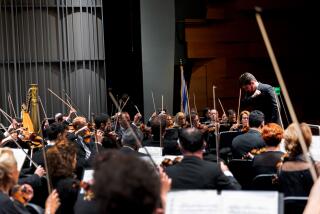A Sampler of Shostakovich Symphonies
- Share via
The simplistic notion that it was all creatively downhill for nearly a half-century after the success of the 19-year-old Dmitri Shostakovich’s wildly original First Symphony (1925) is rooted in the widely held feeling that none of his subsequent symphonies could quite equal its cheekiness--he was never 19 again--or its variety of mood.
Is he deep? Is he superficial? Is he blatant? Yes, to all.
The Sixth Symphony (1939), for instance, commences with a dark, Mahlerian largo whose sadness is of a piece, where elsewhere the composer seems perversely intent on interrupting such moods with noisy, mock-jovial ejaculations, a pattern which has led some observers to question Shostakovich’s ability to develop a theme.
This is followed by a short, fast movement scored with dashing lightness, and another shorter and faster trifle which may be a satire of wretched Soviet gotta-be-jolly music. Then again, it may just be wretched music.
In sum, three isolated orchestral pieces are arbitrarily grouped.
Whatever can be done to illuminate this score is done in the mid-priced reissue (Angel Studio 69564) of Andre Previn’s shapely interpretation with the London Symphony. The same performers do equally well with the coupling: a trim reading of Rachmaninoff’s messy, occasionally gorgeous Third Symphony.
Shostakovich’s hour-long, wartime Eighth Symphony is a palpable depiction of suffering and perhaps a pointed rejoinder to the populist claptrap of its predecessor, the “Leningrad” Symphony.
When the Eighth Symphony is entrusted to its dedicatee, the late Yevgeny Mravinsky, and his Leningrad Philharmonic, one has to listen. These are Shostakovich’s people. No other orchestra, no other conductor is able to muster quite the weighty, throbbing intensity of sound and emotion one hears from these forces.
The present recording (Philips 422 442) has its origins in what was evidently a memorable 1982 concert in Leningrad.
Shostakovich attempted to recapture the friskiness of his First Symphony with the Ninth (1945). By and large he succeeded, creating a work of delicate wit rather than bad-boy satire.
A recent recording from Neeme Jarvi and the Scottish National Orchestra is fleet and incisive, innocently humorous and humorously ominous by turns. Shostakovich’s consummately trashy “Festive Overture,” his ham-handed orchestration of Vincent Youmans’ “Tea for Two” and the powerful sequence of entr’actes from the opera “Katerina Ismailova” complete the program (Chandos 8587).
The Eleventh Symphony, a vast musical mural completed in 1957, bears the subtitle “The Year 1905,” in commemoration of the massacre then of unarmed workers in the square of the Winter Palace at St. Petersburg.
This is music that achieves points of what might be called anguished stasis. One has to listen very closely, particularly to the vast, slow, often barely audible first movement, preferably supplied with clues to the historical events on which it reflects and the contextual meaning of its folk-song quotations.
It is worth the effort. The first of two new recordings of the Eleventh is by the excellent Helsinki Philharmonic under James DePreist (Delos 3080), who offer a splendidly communicative reading--sharply detailed, with a cumulative excitement that climaxes harrowingly in the quickstep death-march of the finale. The playing time of over 68 minutes hardly seems excessive when tension is so masterfully sustained.
On the other hand, in the loud, crude performance by the highly hyped Soviet emigre conductor Semyon Bychkov and the Berlin Philharmonic (Philips 420 935) the symphony becomes amorphous and interminable, despite occupying about nine minutes less time than DePreist’s.
More to Read
The biggest entertainment stories
Get our big stories about Hollywood, film, television, music, arts, culture and more right in your inbox as soon as they publish.
You may occasionally receive promotional content from the Los Angeles Times.










